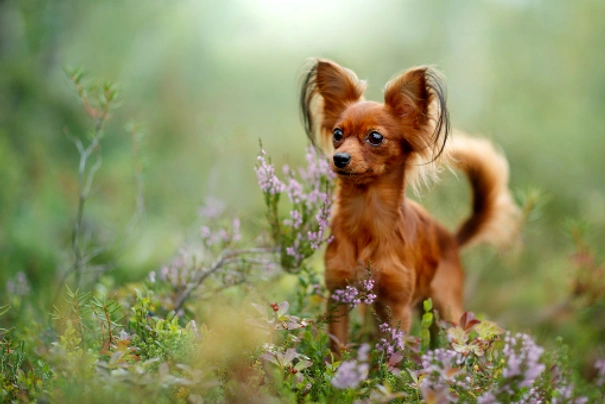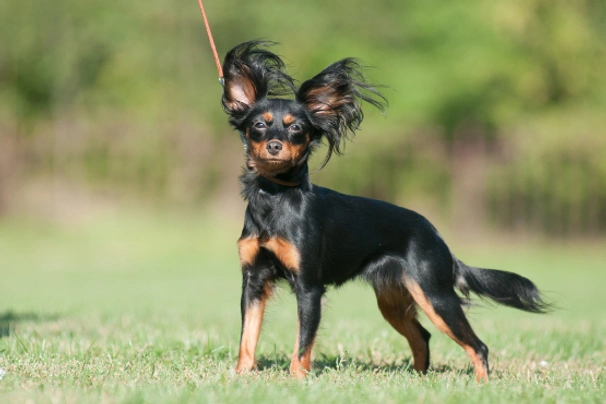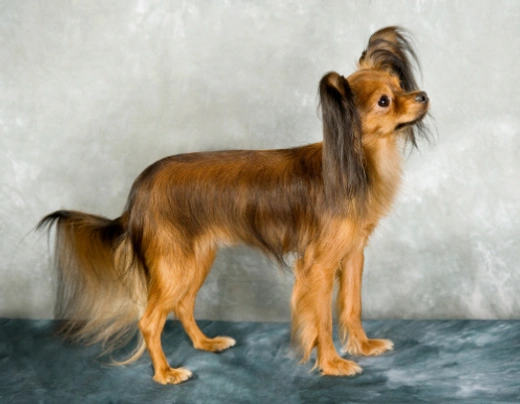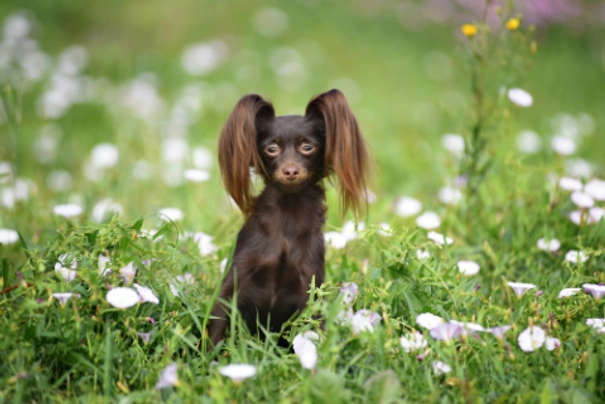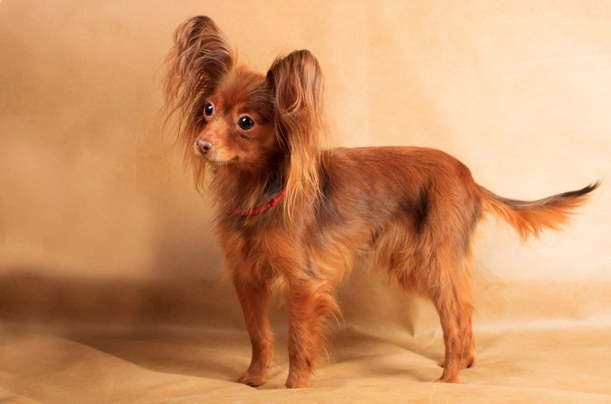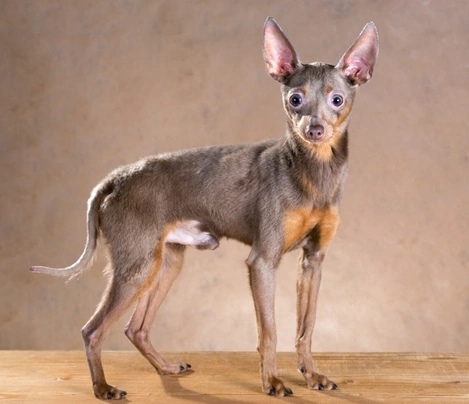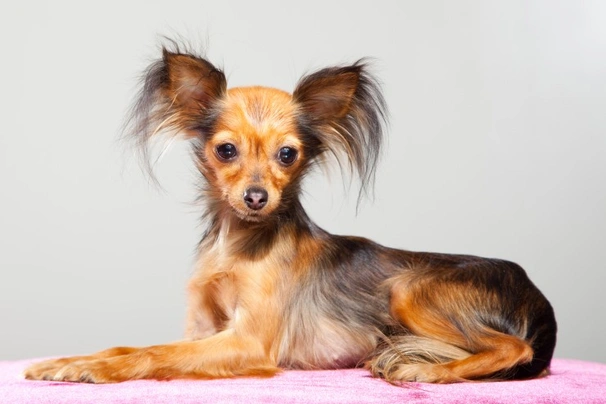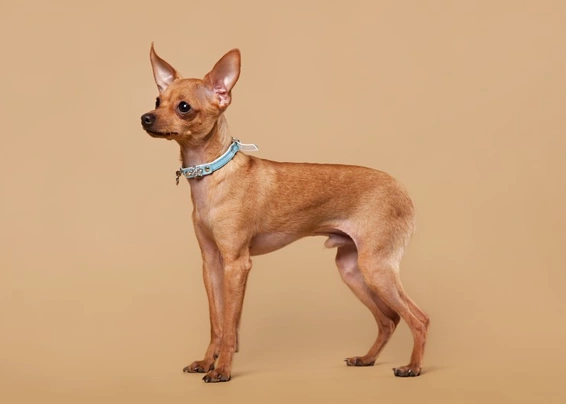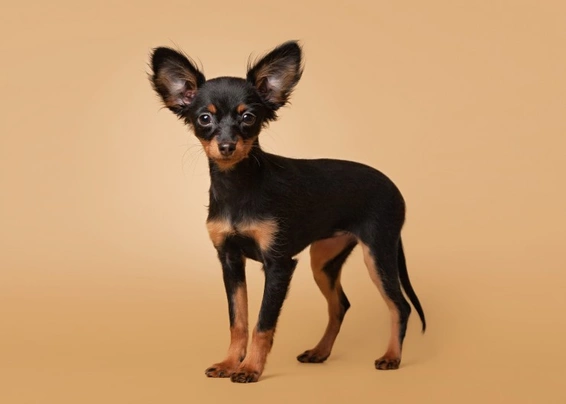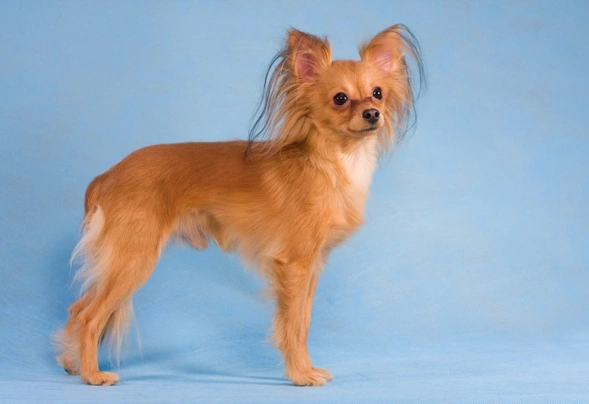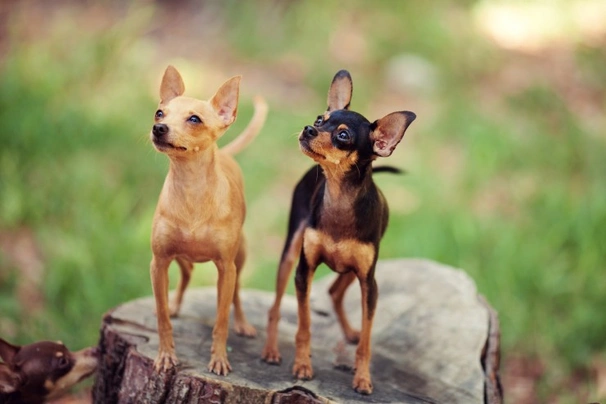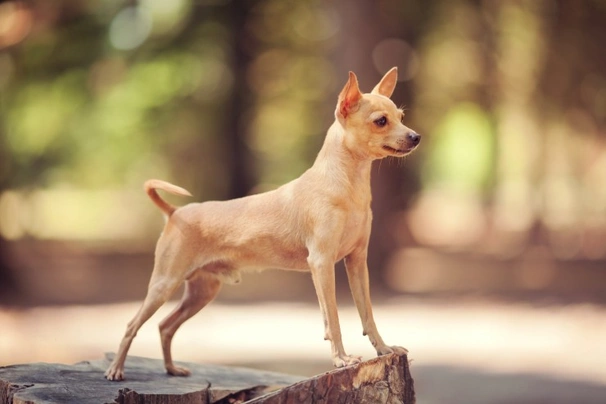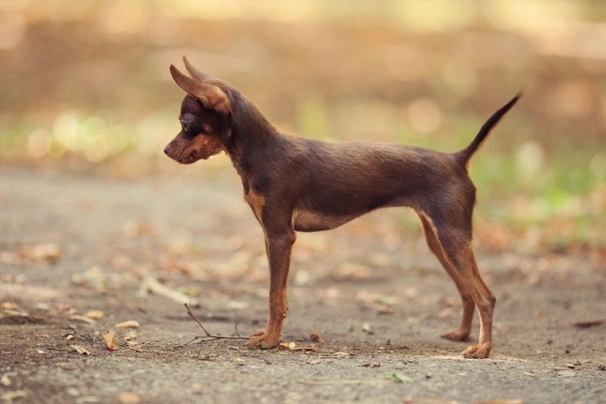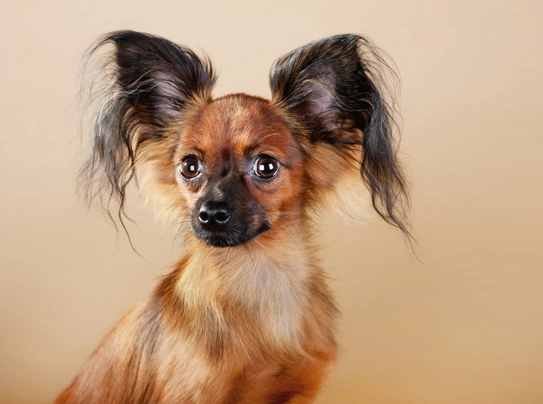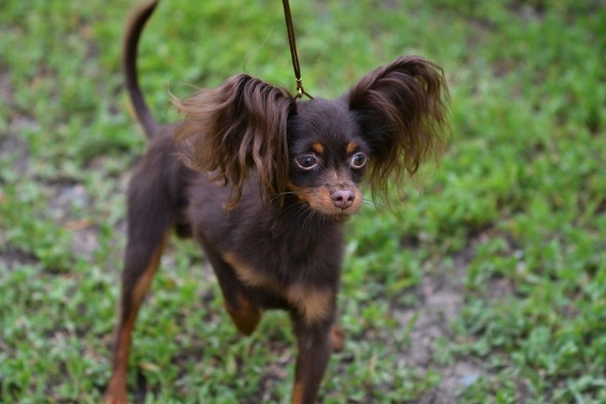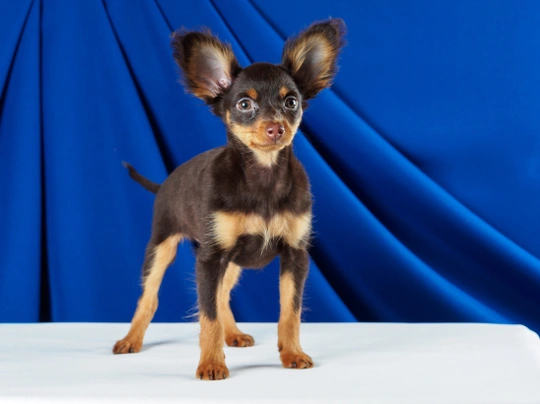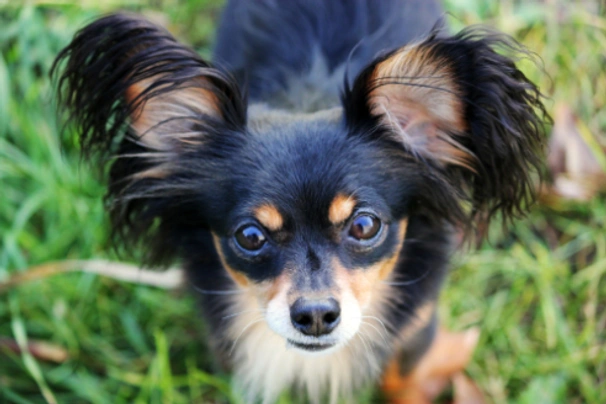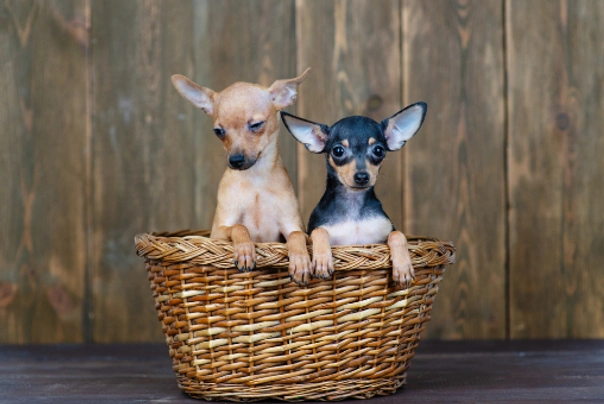Russian Toy Terrier
Pros
Cons
Introduction of the Russian Toy Terrier
Russian Toy Terriers are small in stature but they are energetic lively characters with the added bonus being they also boast having kind affectionate natures which in short means they are great companions to have around. Russian Toys love nothing more than being in a family environment and being included in everything that goes on in a household and although extremely popular in their native Russia these little dogs are only just gaining the recognition they deserve in other parts of the world which includes the UK.
For the moment the breed is not Kennel Club recognised (as at December 2017) and finding a breeder can prove challenging. As such anyone wanting to share a home with a Russian Toy Terrier would need to register their interest with breeders and go on a waiting list for the pleasure of doing so with the good news being that the wait would be well worth it.
History of the Russian Toy Terrier
Terriers have been found in Russia for centuries with records of an English-type terrier having been owned by the Russian Emperor Peter the Great. These little dogs were developed as companions for the Russian upper classes and the nobility and it is thought that 8 smooth haired English-style terriers were exhibited in the Museum of Zoology St Petersburg back in the early 1700's. The terrier's name was Lizetta and she was owned by Peter the Great the Russian Emperor which set the stage for this type of dog being bred and developed for the Russian nobility as companions.
There are records of another 8 smooth-coated Russian Toy Terriers having been exhibited at a St Petersburg show in 1874. However the first official record of them being shown at a dog show in St Petersburg that dates to May 1907.
During the October Revolution of 1917 breed numbers dropped dramatically because these little dogs were linked to the aristocracy and as such owning a Russian Toy Terrier was frowned upon and their numbers dwindled dramatically. Over time a new type of terrier appeared on the scene and it was one that had a very distinct look all of its own. A breed standard was subsequently established and from the mid 1950's onwards the Russian Toy Terriers we see today started to be developed. However it was not until 1958 that the first litter of long haired Russian Toy Terriers appeared on the scene**.** One of the males from the litter was later bred to a female that boasted a slightly longer coat which over the years saw 2 types of Russian Toys being developed namely the long-haired terrier and the short-haired terrier.
A breed standard was drawn up for the smooth haired terrier in 1960 but a standard for the long-haired Russian Toy Terriers was set six years later in 1966 with both being authorised by the Russian Ministry of Agriculture. The breed standard was changed in 1988 and then again in 2003. Six years later in 2006 the breed was recognised by the FCI as being a Companion and Toy Dog under their classification Group 9.
The Russian Kynological Federation then published an updated breed standard in 1988 with the Russian Toy being categorised under Group 3 Terriers Section 4 Miniature Terriers. In 1996 the National Club of Breed "Russian Toy" was founded in Moscow and the breed standard was once again updated in 2003 by the Fédération Cynologique Internationale with this then being approved by the RKF Breeding Commission but this type under Group 9 of Companion and Toy Dogs.
These charming little dogs have remained popular in their native Russia but are less well known in other parts of the world. It was only in 2008 that the first Russian Toy Terriers appeared on the scene here in the UK. A Breed Club was then set up which has led to more people getting to know about these charming little terriers. However anyone wishing to share a home with a Russian Toy Terrier would need to register their interest with a breeder and then agree to be put on a waiting list because puppies are hard to come by.
Interesting facts about the breed
- Is the Russian Toy Terrier a vulnerable breed? No but the breed is quite rare outside of their native Russian although their numbers are slowly rising with their popularity in other countries of the world including the UK
- Peter the Great of Russia owned Toy Terriers and they were extremely popular with the nobility too
- The breed is recognised by the American Kennel Club and a breed standard has been established
- Russian Toys may be tiny in size but they are feisty and protective by nature
- Finding a good breeder can prove challenging because the number of Russian Toy Terriers remains low in the UK
Appearance of the Russian Toy Terrier
Height at the withers: Males 20 - 28 cm Females 20 - 28 cm
Average weight: Males 3 kg Females 3 kg
The Russian Toy Terrier is a charming little dog and although they are tiny in stature they have no idea of just how small they actually are. They are brave loyal and extremely protective of their families and the children in a household. They are elegant with their long legs and fine bones. A Russian Toy's head is quite small in relation to their body and they have a clearly defined stop. They have small noses that match their coat colour. Muzzles are pointed and their cheekbones are very slightly pronounced adding to their charming looks. They have a perfect scissor bite where their upper teeth neatly overlap their lower ones.
Their eyes are round dark and quite large being set well apart on a dog's face. Their ears are large set high and they are upright. Necks are lean and long which dogs carry high and slightly arched. Their topline slopes gently from the wither to the root of the tail and their withers are very slightly pronounced. Backs are straight and strong with dogs boasting short very slightly arched loins and a slightly sloping rounded croup.
Their chest is oval and quite deep with nicely tucked up bellies which gives these little dogs an attractive outline. They have sickle tails which dogs carry happily to the side of their bodies. Their front legs are lean thin and straight with dogs having moderately long shoulder blades. Front feet are oval shaped and small with well-knit arched toes and nails that match a dog's coat colour. Their back legs are straight and parallel with nicely developed upper and lower thighs. Back feet are slightly narrower than the front ones.
When it comes to their coat the Russian Toy Terrier can either have a smooth (short) coat or they can be long-haired. Smooth coated dogs have short shiny hair that lies close to their body without any undercoat. A long-haired dog's coat is longer and can be either slightly wavy or straight lying close to a dog's body so their outline can be clearly seen. The hair on the head and the front of their legs is short but dogs have nice feathering on the back of their legs. The hair on their feet has silky long hair which hides their nails from view. Ears are also well covered with long thick hair which forms a charming fringe. Accepted breed colours under FCI rules are as follows:
- Black and tan
- Brown and tan
- Blue and tan
- Red - any shade with or without a black or brown overlay
It is worth noting that the richer a Russian Toy Terrier's coat is the better.
Gait/movement
When a Russian Toy Terrier moves they do so with an easy fast and straight forward action always keeping their toplines nice and level when they do.
Faults
Prospective owners should be wary of any puppies or dogs that show any sort of exaggeration whether in their looks or conformation and that extra-small Russian Toys often come with many health issues so they are best avoided. A responsible breeder would always ensure that puppies they produce are of a good size and conformation and would avoid breeding extra small dogs for these reasons. Males should have both testicles fully descended into their scrotums.
Temperament of the Russian Toy Terrier
The Russian Toy Terrier is a petite dog but they are lively by nature and love nothing more than to be kept busy although once tired out these little dogs are quite happy to curl up with an owner on the couch. They are the perfect choice for people who lead more sedentary lives and who enjoy the company of a small canine alert and loyal companion at their side. They are known to be quite territorial and think nothing of standing guard over their owners and their possessions even though they are tiny because these little terriers are totally fearless. However a Russian Toy would rarely show any sort of aggressive behaviour preferring to bark and keep their distance until an owner arrives on the scene when strangers are about or when a dog is upset by something. Like many of their terrier cousins the Russian Toy can be a little wary of strangers but as soon as they get to know someone they are fine around them because they are social little dogs by nature.
They form strong bonds with their families and as such do not like being left on their own for long periods of time. If they do find themselves alone these little terriers can suffer from separation anxiety which often sees dogs displaying all sorts of behavioural issues which includes incessant barking and being destructive around the home. Being so intelligent a Russian Toy would soon find inventive ways of amusing themselves which includes destroying anything they can get hold of.
Are they a good choice for first time owners?
Russian Toy Terriers are the perfect choice for first time dog owners because they are so amenable and people-oriented loving nothing more than to please and to entertain their families. They are wonderful companions and family pets in households with older children although they are known to be good around children of all ages.
What about prey drive?
Russian Toys are terriers and although small they cannot resist chasing anything that tries to run away from them which includes the cat from next door. As such care should always be taken as to where and when they can run off the lead when there are other animals around.
What about playfulness?
Russian Toys have a very playful side to their natures and love to entertain and be entertained. They are known to be a little mischievous when the mood takes them and quickly learn how to get their own way by pleasing their owners with their silly antics.
What about adaptability?
Russian Toy Terriers are highly adaptable dogs and providing they are given enough daily physical exercise combined with as much mental stimulation to prevent boredom from setting in they are just as happy living in an apartment in town as they are living in the country with a secure back garden to roam around in.
What about separation anxiety?
Russian Toys form strong ties with their families and dogs are never very happy when they find themselves left on their own for longer periods of time. They are better suited to people who either work from home or in households where one person stays at home when everyone else is out so they are never alone for any length of time which could see a dog suffering from separation anxiety. This can lead to them being destructive around the home which is a dog's way of relieving any stress they are feeling and a way to keep themselves entertained.
What about excessive barking?
Russian Toys are known to like the sound of their own voices a little too much which is something that needs to be gently nipped in the bud when a dog is still young being careful not to frighten them although it can be hard to stop them from barking for the sake of it.
Do Russian Toy Terriers like water?
Because of their small size care should always be taken when a Russian Toy goes swimming and anyone who owns a dog that does not like water should never force them to go in because it would just end up scaring them bearing in mind that they are very sensitive little terriers by nature. Care should also be taken when walking a Russian Toy off the lead anywhere near more dangerous water courses just in case they fall in and need rescuing.
Are Russian Toy Terriers good watchdogs?
Russian Toys as previously mentioned can be quite territorial and although small in stature they are excellent watchdogs always being quick off the mark to let their owners know when strangers are about although rarely would they go about this aggressively preferring to keep their distance and bark.
Intelligence / Trainability of the Russian Toy Terrier
The Russian Toy Terrier is an intelligent little dog and because they love to please they are quick to learn new things. However this means they are just as quick to learn both the good and the bad. Being so cute it's all too easy to let a Russian Toy get away with things a larger dog would never be allowed to do. As such it's important not to spoil them.
They are quite sensitive little characters and although they are quick to learn new things care should be taken as to how a Russian Toy is trained. They do not answer well to any sort of negative harsh correction but they do respond very well to positive reinforcement. It's essential for these little terriers to be well socialised from a young enough age and for their training to start early so they mature into confident yet relaxed adult dogs. Their training should be consistent and fair so that a dog understands what is expected of them.
Because Russian Toy Terrier puppies are incredibly cute so it is all too easy to spoil them when they first arrive in their new homes. However owners must start out as they mean to go on to prevent a dog from developing a condition known as Small Dog Syndrome which makes them willful and harder to live with. As such boundaries and rules must be laid out so that these little terriers understand what is expected of them. It teaches them what is acceptable behaviour and what is not. It also helps establish a pecking order and who is the alpha dog in a household and prevents a small dog from showing a more dominant side to their nature. The first commands a puppy should be taught are as follows:
- Come
- Sit
- Stay
- Heel
- Quiet
- Leave it
- Down
- Bed
Children and other
Russian Toy Terriers love being in a family environment although care must be taken when they are around toddlers and very small children because of their small size. With this said they are good choice for families where the children are older and who therefore know how to behave around such small dogs and how to handle and play with them.
When well socialised from a young enough age the Russian Toy usually gets on well with other dogs but again care must be taken when they are around larger dogs. Because of the "terrier" in them care also should be taken when a Russian Toy meets any small animals and pets and this includes cats. However if they have grown up with a family cat in a household they usually get on well together.
Health of the Russian Toy Terrier
The average life expectancy of a Russian Toy Terrier is between 10 and 11 years when properly cared for and fed an appropriate good quality diet to suit their ages.
Like many other breeds the Russian Toy is known to suffer from a few hereditary health issues which are worth knowing about if you are planning share your home with one of these lively little terriers. The conditions that seem to affect the breed the most include the following:
- Progressive retinal atrophy (PRA) – dogs should be eye tested through British Veterinary Scheme
- Patella luxation
- Legg-Calves-Perthes disease
- Teething issues (puppies and young dogs) – Often requires veterinary attention
What about vaccinations?
Russian Toy puppies would have been given their initial vaccinations before being sold but it is up to their new owners to make sure they have their follow-up shots in a timely manner with the vaccination schedule for puppies being as follows:
- 10 -12 weeks old bearing in mind that a puppy would not have full protection straight away but would be fully protected 2 weeks after they have had their second vaccination
There has been a lot of discussion about the need for dogs to have boosters. As such it's best to talk to a vet before making a final decision on whether a dog should continue to have annual vaccinations which are known as boosters.
What about spaying and neutering?
A lot of vets these days recommend waiting until dogs are slightly older before spaying and neutering them which means they are more mature before undergoing the procedures. As such they advise neutering males and spaying females when they are between the ages of 6 to 9 months old and sometimes even when a dog is 12 months old.
Other vets recommend spaying and neutering dogs when they are 6 months old but never any earlier unless for medical reasons. With this said many breeds are different and it is always advisable to discuss things with a vet and then follow their advice on when a dog should be spayed or neutered.
What about obesity problems?
Like many other toy breeds the Russian Toy can gain weight once they have been spayed or neutered and it's important to keep an eye on a dog's waistline just in case they do. If a dog starts to put on weight it's important to adjust their daily calorie intake and to up the amount of exercise they are given. Older dogs too are more prone to gaining weight and again it's essential they be fed and exercised accordingly because obesity can shorten a dog's life by several years. The reason being that it puts a lot of extra strain on a dog's internal organs including the heart which could prove fatal.
What about allergies?
Some Russian Toys are prone to suffering from allergies and it's important for a dog to see a vet sooner rather than later if one flares up. Allergies can be notoriously hard to clear up and finding the triggers can be challenging. With this said a vet would be able to make a dog with an allergy more comfortable while they try to find out the triggers which could include the following:
- Certain dog foods that contain high levels of grain and other cereal fillers
- Airborne pollens
- Dust mites
- Environment
- Flea and tick bites
- Chemicals found in everyday household cleaning products
Participating in health schemes
All responsible Russian Toy Terrier breeders would ensure that their stud dogs are tested for known hereditary and congenital health issues known to affect the breed by using the following schemes:
- Eye test for progressive retinal atrophy (PRA)
What about breed specific breeding restrictions?
The Russian Toy Terrier is not KC registered as such there are not breed specific breeding restrictions in place.
What about Assured Breeder Requirements?
For the moment the breed is not Kennel Club registered as such there are no Assured Breeder requirements in place for Russian Toys. However prospective owners should always seek out reputable breeders who do their best to breed healthy puppies.
Caring for the Russian Toy Terrier
As with any other breed Russian Toys need to be groomed on a regular basis to make sure their coats and skin are kept in top condition. They also need to be given regular daily exercise to ensure they remain fit and healthy. On top of this dogs need to be fed good quality food that meets all their nutritional needs throughout their lives.
Caring for a Russian Toy Terrier puppy
Like all puppies Russian Toys are boisterous and full of life which means it's essential for homes and gardens to be puppy-proofed well in advance of their arrival especially as they are such small dogs. A responsible breeder would have well socialised their puppies which always leads to more outgoing confident and friendly dogs right from the word go. With this said any puppy is going to feel vulnerable when they leave their mother and littermates which must be taken into account. The longer a puppy can remain with their mother the better although it should never be for too long either.
It's best to pick a puppy up when people are going to be around for the first week or so which is the time needed for a puppy to settle in. Puppy-proofing the home and garden means putting away any tools and other implements that a boisterous puppy might injure themselves on. Electric wires and cables must be put out of their reach because puppies love chewing on things. Toxic plants should be removed from flowerbeds and the home too.
Puppies need to sleep a lot to grow and develop as they should which means setting up a quiet area that's not too out of the way means they can retreat to it when they want to nap and it's important not to disturb them when they are sleeping. It's also a good idea to keep "playtime" nice and calm inside the house and to have a more active "playtime" outside in the garden which means puppies quickly learn to be less boisterous when they are inside.
The documentation a breeder provides for a puppy must have all the details of their worming date and the product used as well as the information relating to their microchip. It is essential for puppies to be wormed again keeping to a schedule which is as follows:
- Puppies should be wormed at 6 months old
- They need to be wormed again when they are 8 months old
- Puppies should be wormed when they are 10 months old
- They need to be wormed when they are 12 months old
Things you'll need for your puppy
There are certain items that new owners need to already have in the home prior to bringing a new puppy home. It's often a good idea to restrict how much space a puppy plays in more especially when you can't keep an eye on what they get up to bearing in mind that puppies are often quite boisterous which means investing in puppy gates or a large enough playpen that allows a puppy the room to express themselves while keeping them safe too. The items needed are therefore as follows:
- Good quality puppy or baby gates to fit on doors
- A good well-made playpen that's large enough for a puppy to play in so they can really express themselves as puppies like to do
- Lots of well-made toys which must include good quality chews suitable for puppies to gnaw on bearing in mind that a puppy will start teething anything from when they are 3 to 8 months old
- Good quality feed and water bowls which ideally should be ceramic rather than plastic or metal
- A grooming glove
- A slicker brush or soft bristle brush
- Dog specific toothpaste and a toothbrush
- Scissors with rounded ends
- Nail clippers
- Puppy shampoo and conditioner which must be specifically formulated for use on dogs
- A well-made dog collar or harness
- A couple of strong dog leads
- A well-made dog bed that's not too small or too big
- A well-made dog crate for use in the car and in the home that's large enough for a puppy to move around in
- Baby blankets to put in your puppy's crate and in their beds for when they want to nap or go to sleep at night
Keeping the noise down
All puppies are sensitive to noise including Russian Toy Terrier puppies. It's important to keep the noise levels down when a new puppy arrives in the home. TVs and music should not be played too loud which could end up stressing a small puppy out.
Keeping vet appointments
As previously mentioned Russian Toy puppies would have been given their first vaccinations by the breeders but they must have their follow up shots which is up to their new owners to organise. The vaccination schedule for puppies is as follows:
- 10 -12 weeks old bearing in mind that a puppy would not have full protection straight away but would only be fully protected 2 weeks after they have had their second vaccination
When it comes to boosters it's best to discuss these with a vet because there is a lot of debate about whether a dog really needs them after a certain time. However if a dog ever needed to go into kennels their vaccinations would need to be fully up to date.
What about older Russian Toy Terriers when they reach their senior years?
Older Russian Toys need lots of special care because as they reach their golden years they are more at risk of developing certain health concerns. Physically a dog's muzzle may start to go grey but there will be other noticeable changes too which includes the following:
- Coats become coarser
- A loss of muscle tone
- Russian Toys can either become overweight or underweight
- They have reduced strength and stamina
- Older dogs have difficulty regulating their body temperature
- They often develop arthritis
- Immune systems do not work as efficiently as they once did which means dogs are more susceptible to infections
Older dogs change mentally too which means their response time tends to be slower as such they develop the following:
- They respond less to external stimuli due to impaired vision or hearing
- They tend to be a little pickier about their food
- They have a lower pain threshold
- Become intolerant of any change
- Often an older dog can feel disorientated
Living with a Russian Toy Terrier in their golden years means taking on a few more responsibilities but these are easily managed and should include looking at their diet the amount of exercise they are given how often their dog beds need changing and keeping an eye on the condition of their teeth.
Older Russian Toy Terriers need to be fed a good quality diet that meets their needs at this stage of their lives all the while keeping a close eye on a dog's weight. A rough feeding guide for older dogs is as follows bearing in mind they should be fed highly digestible food that does not contain any additives:
- Protein content should be anything from 14 – 21%
- Fat content should be less than 10%
- Fibre content should be less than 4%
- Calcium content should be 0.5 – 0.8%
- Phosphorous content should be 0.4 – 0.7%
- Sodium content should be 0.2 – 0.4%
Older Russian Toys don't need to be given the same amount of daily exercise as a younger dog but they still need the right amount of physical activity to maintain muscle tone and to prevent a dog from putting on too much weight. All dogs need access to fresh clean water and this is especially true of older dogs when they reach their golden years because they are more at risk of developing kidney disorders.
Grooming of the Russian Toy Terrier
The smooth haired Russian Toy Terrier is low maintenance in the grooming department and only really needs a quick once over several times a week to keep their coats tidy. However a long haired Russian Toy needs a daily brush to prevent tangles and matts from forming. It's also essential to keep an eye on a dog's teeth and more especially when they are going through their teething stage. If there is a problem it's best to seek veterinary attention sooner rather than later.
It's also important to check a dog's ears on a regular basis and to clean them when necessary. If too much wax builds up in a dog's ears it can lead to a painful infection which can be hard to clear up. In short prevention is often easier than cure when it comes to ear infections.
Exercise of the Russian Toy Terrier
Russian Toy Terriers are alert lively and energetic little dogs and they like to be kept busy although once tired they are quite happy to chill out on a sofa next to their owners. With this said they need to be given at least 20 to 30 minutes a day for them to stay fit happy and healthy.
A shorter walk in the morning would be fine but a longer more interesting one in the afternoon is a must. These dogs also like to roam around a back garden as often as possible so they can really let off steam. However the fencing must be extremely secure to keep these lively little dogs in because if they find a weakness in the fence they will soon escape out and get into all sorts of trouble.
With this said Russian Toy puppies should not be over exercised because their joints and bones are still growing. This includes not letting a dog jump up and down from furniture or going up or down the stairs. Too much pressure placed on their joints and spines at an early age could result in a dog developing problems later in their lives.
Feeding of the Russian Toy Terrier
If you get a Russian Toy puppy from a breeder they would give you a feeding schedule and it's important to stick to the same routine feeding the same puppy food to avoid any tummy upsets. You can change a puppy's diet but this needs to be done very gradually always making sure they don't develop any digestive upsets and if they do it's best to put them back on their original diet and to discuss things with the vet before attempting to change it again.
Older dogs are not known to be fussy or finicky eaters but this does not mean you can feed them a lower quality diet. It's best to feed a mature dog twice a day once in the morning and then again in the evening making sure it's good quality food that meets all their nutritional requirements. It's also important that dogs be given the right amount of exercise so they burn off any excess calories or they might gain too much weight which can lead to all sorts of health issues. Obesity can shorten a dog's life by several years so it's important to keep an eye on their waistline from the word go.
Feeding guide for a Russian Toy Terrier puppy
Puppies need to be fed a highly nutritious good quality diet for them to develop and grow as they should. As a rough guide a Russian Toy puppy can be fed the following amounts every day making sure their meals are evenly spread out throughout the day and it's best to feed them 3 or 4 times a day:
- 2 months old - 58g to 62g depending on puppy's build
- 3 months old - 64g to 68g depending on puppy's build
- 4 months old - 65g to 74g depending on puppy's build
- 5 months old - 65g to 69g depending on puppy's build
- 6 months old - 57g to 61g depending on puppy's build
- 7 months old - 50g to 54g depending on puppy's build
- 8 months old - 49g to 53g depending on puppy's build
- 9 months old - 49g to 53g depending on puppy's build
- 10 months old - 49g to 53g depending on puppy's build
Once a puppy is 11 months old they can be fed adult dog food.
Feeding guide for an adult Russian Toy Terrier
Once fully mature an adult Russian Toy must be fed a good quality diet to ensure their continued good health. As a rough guide an adult dog can be fed the following amounts every day:
- Dogs weighing 3 kg can be fed 55g to 63g depending on activity
Russian Toy Terrier price
If you are looking to buy a Russian Toy Terrier you would need to register your interest with breeders and agree to go on a waiting list because puppies are few and far between and you would need to pay anything from £600 to over £800 for a well-bred pedigree puppy.
The cost of insuring a male 3-year-old Russian Toy Terrier in northern England would be £20.98 a month for basic cover but for a lifetime policy this would set you back £42.82 a month (quote as of December 2017). When insurance companies calculate a pet's premium they factor in several things which includes where you live in the UK a dog's age and whether they have been neutered or spayed among other things.
When it comes to food costs you need to buy the best quality food whether wet or dry to feed your dog making sure it suits the different stages of their lives. This would set you back between £20 - £30 a month. On top of this you need to factor in veterinary costs if you want to share your home with a Russian Toy and this includes their initial vaccinations their annual boosters the cost of neutering or spaying a dog when the time is right and their yearly health checks all of which quickly adds up to over £800 a year.
As a rough guide the average cost to keep and care for a Russian Toy Terrier would be between £50 to £80 a month depending on the level of insurance cover you opt to buy for your dog but this does not include the initial cost of buying a well-bred healthy Russian Toy Terrier puppy.
Buying advice
When visiting and buying any puppy or dog there are many important things to consider and questions to ask of the breeder/seller. You can read our generic puppy/dog advice here which includes making sure you see the puppy with its mother and to verify that the dog has been wormed and microchipped.
Russian Toy Terriers are quite hard to find because for the moment there are very few reputable breeders in the UK which means that well-bred puppies can often command a lot of money. As such with Russian Toys there is specific advice questions and protocols to follow when buying a puppy which are as follows:
- Beware of online scams and how to avoid them. You may see online and other adverts by scammers showing images of beautiful Russian Toy Terrierpuppies for sale at very low prices. However the sellers ask buyers for money up front before agreeing to deliver a puppy to a new home. Potential buyers should never buy a puppy unseen and should never pay a deposit or any other money online to a seller. You should always visit the pet at the sellers home to confirm they are genuine and make a note of their address.
- As previously touched upon anyone wanting to buy a Russian Toy would need to register their interest with breeders making sure they are reputable because there are many amateur breeders/people who breed from a dam far too often so they can make a quick profit without caring for the welfare of the puppies their dam or the breed in general. Although Russian Toys are not a Kennel Club registered breed all breeders should follow the breeding guidelines as set out by the KC which are that a dam can only produce 4 litters and she must be between a certain age to do so. Anyone wishing to buy a Russian Toy puppy should think very carefully about who they purchase their puppy from and should always ask to see the relevant paperwork pertaining to a puppy's lineage their vaccinations and their microchipping.
- Prospective owners should be very careful when considering buying an extra small puppy because all too often they suffer from very serious health issues and no responsible breeder would purposefully breed dogs so they are too small.
- Prospective owners should also be very wary of buying Russian Toy Terriers that have been bred abroad before being imported to the UK and should ask breeders for all the relevant important documentation before buying a puppy from them.

XXS Russian toy terrier boy🧸SOLD
£1,500
Mini Toy terjer♂️ the last boy❤️
£1,000
